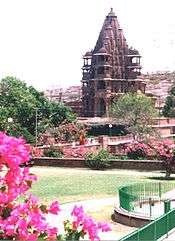Mandore
| Mandore | |
|---|---|
| town | |
 Mandore  Mandore Location in Rajasthan, India | |
| Coordinates: 26°21′13″N 73°01′59″E / 26.3535°N 73.0331°ECoordinates: 26°21′13″N 73°01′59″E / 26.3535°N 73.0331°E | |
| Country |
|
| State | Rajasthan |
| Languages | |
| • Official | Hindi |
| Time zone | IST (UTC+5:30) |
| Nearest city | Jodhpur |
| Lok Sabha constituency | Jodhpur |
| Vidhan Sabha constituency | Sardarpura |
Mandore (Hindi: मंडोर), is a town located 9 km north of Jodhpur city, in the Indian state of Rajasthan.
History
Mandore is an ancient town, and was the seat of the Pratiharas of Mandavyapura, who ruled the region in the 6th century CE. The rulers of this dynasty probably became vassals of the imperial Gurjara-Pratiharas.[1] After the disintegration of the Gurjara-Pratihara empire, one branch of Pratiharas continued to rule at Mandore. In 1395 CE, a princess of this branch married Rao Chunda of Rathore clan. Rao Chunda received the Junagarh fort in Mandore in dowry, and moved his capital to the site. The town remained the Rathore capital until 1459 CE, when Rao Jodha shifted his capital to the newly founded city of Jodhpur.[2]
Mandore was the capital of the erstwhile princely state of Marwar (Jodhpur State), before moving to Mehrangarh Fort in Jodhpur.[3]
Monuments

The historic town boasts several monuments. The now ruined Mandore fort, with its thick walls and substantial size, was built in several stages and was once a fine piece of architecture. A huge, now ruined temple is a highlight of the fort. The outer wall of the temple depicts finely carved botanical designs, birds, animals and planets.

The 'Mandore gardens', with its charming collection of temples and memorials, and its high rock terraces, is another major attraction. The gardens house the Chhatris (cenotaphs) of many rulers of Jodhpur state. Prominent among them is the chhatri of Maharaja Ajit Singh, built in 1793.[3]
Ravan temple is another attraction at Mandore. It is believed to be the native place of Ravan's wife Mandodari. Ravan is treated as son in law among some local Brahmins.[4]
The Mandore Gardens also house a government museum, a 'Hall of Heroes' and a Hindu temple to 33 crore gods.[3] Various artefacts and statues found in the area are housed at the museum. The 'Hall of Heroes' commemorates popular folk heroes of the region. It contains 16 figures carved out of a single rock. Next door is a larger hall called "The temple of 33 crore gods" which houses images of various Hindu deities.[3]
Fairs and festivals
- The Rao Festival
- Hariyali Amavasya
- Naag Panchami
- Veerpuri Mela[5]
- BhogiShell Parikrama
See also
References
- ↑ Baij Nath Puri (1957). The history of the Gurjara-Pratihāras. Munshiram Manoharlal. p. 19. OCLC 2491084.
- ↑ Melia Belli Bose (2015). Royal Umbrellas of Stone: Memory, Politics, and Public Identity in Rajput ... BRILL. p. 139. ISBN 9789004300569.
- 1 2 3 4 "Mandore Garden". Rajasthan Tourism. Retrieved 5 March 2015.
- ↑ Times Of India (14 October 2015). "Saluting the virtues of Ravan". Shailvee Sharda. Lucknow. Times Of India. Retrieved 14 October 2015.
- ↑ Premji (18 August 2015). "Jodhpur - Blue City of India". Andhra Telangana Vishesh. Retrieved 14 October 2015.